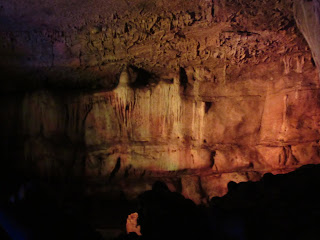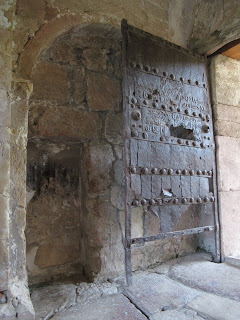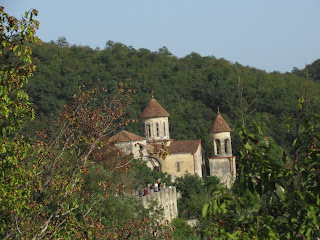Our home stay hostess had prepared hot dogs – still in their
casings – mashed potatoes, fresh sliced tomatoes, cheese, bread and the fluffiest
omelet I ever had for breakfast. Fortunately, we've gotten sort of used to having potatoes for the first meal of the day in Georgia as they must be a staple for Georgians' breakfasts. Just like at the other breakfasts, there was
enough food to see us through to dinner which was great as there were no food or beverage stops
on the day trips from Kutaisi.
Our room in Kutaisi was in the local apartment at the top of the stairs - way different than what either Steven or I envisioned but it worked out fine in the end.Close ups of the fantastic figures in the grand Colchis Fountain in the central square we'd also seen our first day in Kutaisi:
Before our day trip to a couple of monasteries and a cave
that would begin at 11, we had enough time to stop in at the Kutaisi Historical Museum. According to
Lonely Planet, it had superb collections from all over western Georgia. I wrote in the post to our visit to the Stalin Museum in Gori about how we had encountered some museum staff who were insistent that we
see things in certain order. That was again the case here although why it
mattered to the staff in which order we saw items in a particular room is a
mystery to me!
16th century grape press:
This 12th century Gospels Manuscript was a gift from Gelati Monastery which we would see later in the day as part of our tour.
This 12th century manuscript on parchment came from Motsameta Monastery, the final stop of that day's tour.
The 16th and 17th century handwritten, miniature manuscripts included golden and colored paintings done in a multi-layer painting technique.
The highlight of the museum was its Golden Fund section with a wonderful exhibition of icons and
crosses in precious metals and jewels.
This was the first time I recall seeing simply War Participation Medals. Perhaps it was a matter of ‘lost in translation’
and the medals may have been awarded in recognition for particular service?
Even admiring the icons, it only took us about fifteen minutes to
walk around the museum. We still had plenty of time to sit in the central park and admire
the sculptures and fountains before waiting for the tour to begin.
Many posts ago, I wrote about the large number of stray dogs
all over Georgia. We have become used to seeing stray dogs while traveling
through many of the former Soviet Bloc countries over the years so they came as
no surprise here.
I continued to be amazed, though, at how incredibly docile and quiet they have all been, amazing as that must sound to someone who’s not seen them first hand. Back home, dogs on the loose never seem to be so quiet! This one followed us for several blocks as we made our way to the visitors' information center to meet our driver.
Only a couple from Romania joined us for our day's tour. The couple remarked how cheap it had been to fly on Wizz Air, one of the European discount airlines,
to Kutaisi. We hadn’t realized before coming that Kutaisi’s airport had become
a hub for cheap international flights and that was why we had come across so
many young people touring Georgia.
Our guide, Kristine, mentioned that the cave was 1,420 meters long and that we would be seeing four of the seventeen halls. The temperature was a constant 14 degrees with 95% humidity! The caves had been discovered in 1984 but only opened to the public in 2011 because of the tough political situation in the country.
The cave had several lakes, one of which was here!
The cave was named for Prometheus who under Greek mythology stole fire from gods.
Looking at the pictures now for the first time since taking them makes me realize I should have used the flash more to get better shots. At the time, I thought the photos were fine but I'm having second thoughts now - oh well, can't do anything about that now!
I have mixed feelings about most caves' use of colored lights as they seem pretty on one hand and yet so artificial on the other. Here's the same photo - with just white lights and then colored ones. Which do YOU like best?
Do you ever get confused between what's a stalactite and what's a stalagmite? I read this hint online so I can remember: stalactites grow from the cave ceiling, to hold on “tite;” stalagmites grow from the cave floor with all of their “mite." Each type only grows one centimeter a year!
Whatever the specific type of formation, they were all beautiful!
By the time we’d reached the second hall, Kolxeti, we had already walked through
a third of the cave.
In the past, some of the halls at Prometheus Cave had classical
music playing but Kristine said there had been technical problems with the system
lately. I was glad to view the caves without the added distraction or
accompaniment of music.
Kristine commented that people with lung conditions and
other issues have seen their heath improve after spending time in the cave
because of certain minerals present in the cave.
I thought this formation looked like ribbons of fresh pasta coming out of a pasta machine!
The cutesy-named Hall
of Love was next. Kristine said civil marriages are performed here!
Before so many people began touring the cave, bats lived in
this section of the cave, thus causing the black spots on the ceiling. They
have had to move to other sections to get away from the lights and people.
The huge open area just ahead was Hall of Prometheus. Nearby was where the first spelunkers had entered the cave in 1984. It was the lowest part of the cave at just 80 masl. When it rains a lot, the underground river in the cave overflows causing this hall to be completely covered.
The couple from Romania and we had both opted to take the
boat ride on the 400-meter long underground lake, figuring it would be another
fun experience! I was sure glad helmets were provided as there were several
places we had to duck our heads way down or risk getting our noggins hit on the
low roof!
Oops - better duck!
The walk through the caves was about an hour long and was the perfect pace, allowing for plenty of photo stops! The boat ride was way too short but a fun way to end our
trip to the caves!
We stopped next at the Sataplia
Nature Reserve. If the four of us wanted an English-language tour of the
reserve, we would have had to wait a long time so we all agreed to go with the
guide who spoke Georgian and Russian as we were assured there would be enough
signs to understand what we were seeing.
The highlight of the reserve were the two dozen 120-million-year old,
fossilized dinosaur footprints displayed in a protective building. But, without
the benefit of information from the guide, seeing them wasn’t as special as it
would it have been otherwise.
In 1933, a local professor discovered the dinosaur footprints and it was later determined they belonged to dinosaurs who lived in the Cretaceous period. Footprints of both raptor reptiles and grass feeding ones were found in two layers of limestone.
If you click on the photo to make it bigger, you will see Steven's pointing to a sign for Jurassic Park!
It was fun walking through the nature reserve and seeing the
different types of dinosaur carvings. You can imagine how much fun the younger kids had when they came across the stegosaurus, the tyrannosaurus and the other types. Oh, to have their enthusiasm and fresh outlook!
Sataplia Mountain was known as the best living environment for a strong bee population even before the discovery of dinosaur footprints and the designation of the area as a Protected Area. Since ancient times, the residents of nearby villages have followed beekeeping. That is why the mountain was called Sataplia or 'place of honey.' Accumulated honey in the crevices was historically used by the locals. Thankfully, we didn’t see or hear any bees as we walked past the crevices toward a small cave.
We had marvelous views of the entire reserve from the path.
The schematic of the cave at the entrance indicated we'd be going past Transparent Hall and Stony Heart Hall among other peculiar names. However do people come up with these names!
The walk through the Sataplia Cave was nothing much compared to the
amazing rock formations we had just seen at Prometheus. Plus, somehow the four
of us lost sight of the guide and the rest of the group altogether and wandered
around down there by ourselves!
This was the really fun couple from Romania we were so lucky to be spending a good chunk of the day with! Being with them made the day even more special.
The reserve was covered with a thick sub-tropical Colchic forest which was enjoyable to walk/hike through.
We had more energy than the Romanian couple so walked a few hundred meters there and back to the Petre Chabukiani Memorial Stone in honor of the man who discovered the dinosaur footprints back in 1933.
We had great panoramic views were available from this spaceship-looking viewpoint.
I could have done without the see-through glass panel walkway that extended way out over the mountain, especially after the canyon walk yesterday!
Being able to view the footprints had been interesting, we had had a nice walk through the nature reserve but
stopping at the caves had hardly been worth it.
We had already determined that Georgians had a singular
talent for choosing beautiful and difficult to access locations for their
places of worship and the famous Gelati Monastery complex was no exception as it was
situated on a wooded hillside northeast of Kutaisi! During Georgia’s medieval ‘Golden Age,’ Gelati was seen as its cultural hub. Many Georgian rulers were buried there including the great 12th century king known as David the Builder. After King David founded Gelati in 1106, it became known in the Middle Ages as ‘a second Jerusalem’ and a ‘new Athens.’ When the communists came to power, the monks were forced to leave in 1922 but the churches were reconstructed in 1988.
Andrew: As you know, the cross known as St. Nino's is famous for Georgians.
The Cathedral of the Virgin was the showpiece of the monastery complex.
One of the most beautiful sights was of a famous mosaic of the Virgin and Child created in the 1120s above the altar.
Frescoes showing the Archangels Michael and
Gabriel looked down from the ceiling.
Between one wall of windows was a line of seven noble figures including King David holding the church. Bagrat III was depicted with a cross over his left shoulder.
Just steps from the Cathedral’s entrance was the open-air Church of St. Nicholas.
On the other side of it was the recently renovated Academy where philosophy, theology,
sciences and painting were taught and important chronicles and translations
were written.
Inside the monastery's South Gate lay the grave of David the Builder as he wanted all who entered the monastery to
step on his tomb.
We read that ironically reverent visitors try hard not to step on it but we made sure to each place one foot on the grave as was intended.
As the smaller Church of St. George was undergoing total
renovations, it was closed to visitors. By then, we had gone to so many Georgian churches and
monasteries throughout much of the country. For me, the UNESCO-listed Gelati
Monastery complex was the most beautiful of all that we had seen. Having read so much about David the Builder from his connections to other monasteries we had already been lucky enough to explore, I felt a closeness to him and seeing his final resting place was extremely special.
Our final stop of the day and in Kutaisi was at Motsameta Monastery which was located
on a spectacular clifftop above a bend of the Tskhalsitela River. Of course to get there, we had a nice hike!
The river’s name, meaning 'Red Water,’ comes from an 8th century massacre by the Arabs. Among the victims were brothers who were Dukes of Arvgeti. According to the story, their bodies were thrown into the river, but then miraculously brought up to the church. The brothers' bones were kept in a side altar in the church.
How sad that as we walked toward the monastery and a place of beauty there had to be such a sign.
We were fortunate that a service was going on when we
visited that late afternoon as it made our visit infinitely more special.
Thank goodness we had no more plans to visit any more
churches in Georgia as both of us were almost ‘churched out’ after seeing so
many churches and monasteries the last couple of weeks!
Next post: Onto the resort city of Batumi on the Black Sea!
Posted on September 7th, 2018, from Baku, Azerbaijan, on the Caspian Sea!





























































































































I've been through plenty of caves & selagtites or the selagmites can make some scary formations or shadows they never gave me nightmares. But faces coming out of a wall is just freaky.
ReplyDeleteThat fridge reminds me of a freezer in Krakow Poland where they used to keep their dead during the winter when it's too cold to bury the graves
ReplyDelete